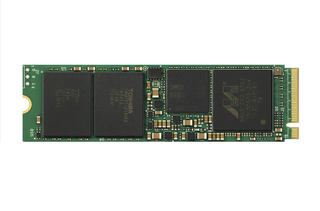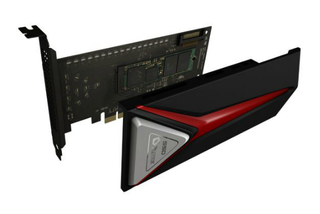Plextor M8Pe NVMe SSDs Spotted With Pricing And Specs
We spoke with Plextor last week and learned that M8Pe samples would be ready for Flash Memory Summit, which is an annual event that takes place in August each year. The M8Pe marks Plextor's first NVMe SSD and only the fourth consumer-focused NVMe product to reach the 1TB barrier. Surprisingly, we spotted pricing and specifications for the final retail products while shopping at Newegg.

Plextor will launch the M8Pe series in no less than twelve product SKUs. At the heart of each drive is a Marvell 88SS1093 "Eldora" controller, which is the successor to the Alta Plus controller that Kingston used in its Predator PCIe SSD. Plextor initially planned to release the M7e with the Marvell Alta Plus SSD controller, but the company canceled the project in August of 2015 due to Marvell's long delay. The first showing of the next-gen Eldora operating at 2,900 MB/s also likely influenced the delay.
At Computex 2015, Marvell told us the 8-channel Eldora and 4-Channel Eldora Lite controllers would come to market by the holiday season, but that schedule apparently slipped. The delay left Plextor without a competitive enthusiast SSD product for two years.
Plextor paired the M8Pe with Toshiba 15nm MLC NAND flash and a Samsung LPDDR3 memory package. The images we found online reveal that the smaller-capacity SSDs ship in a single-sided configuration for use in notebooks (as shown above). Plextor also prepared three products in the M.2 2280 form factor with a heatsink over the components. A third configuration puts the bare M.2 2280 SSD in an add-in card for use in desktop PCs.

Let's take a look at the Eldora controller, and then examine how it helped shape the new Plextor M8Pe product line.
Marvell 88SS1093 "Eldora" Overview
Applications
- Extreme Line Client SSDs
- Data Center Flash Storage
Benefits
Stay on the Cutting Edge
Join the experts who read Tom's Hardware for the inside track on enthusiast PC tech news — and have for over 25 years. We'll send breaking news and in-depth reviews of CPUs, GPUs, AI, maker hardware and more straight to your inbox.
- 28nm Process Node
- 3rd Generation Low-Density Parity Check (LDPC) Technology
Features
- Fully Hardware Automated NVMe 1.1 Support
- Command Overlay And Out-Of-Order Data Return
- Hardware Automation On Command Fetch And Status Return
- 15nm TLC / MLC / SLC And 3D NAND Support With Marvell NANDEdge (TM) LDPC ECC And Management
- Advanced Tri-Core CPU Architecture To Support High-Performance Requirements
- SRIS Capabilities To Support SATA Express Running PCIe 3.0 Speed
- Support Up To 2TB
- M.2 / 2.5-Inch Slim Form Factor Support With Thermal Optimization And Small Package Size
- Low-Power Management (L1.2) Design
- Advanced 28nm CMOS Process
Like other next-generation products from the company, the Eldora controller uses the MoChi modular design method, which means that the company assembles disparate semiconductor components to make the end products. We learned at Computex 2016 that MoChi spreads across several different platforms. For instance, if Marvell wanted to add a 10-gigabit Ethernet module to the Eldora controller, it could do so. A more likely scenario would be to add NVMe SSD cache to a Marvell NAS controller or a chip that controls television functions.
The 88SS1093 is the first PCIe controller to come to market with advertised SRIS compatibility. SRIS is a dedicated internal timing clock needed to support SATA Express, which indicates that we may finally see a SATA Express SSD in the near future.
Finally, the new controller was built to support 15nm Toshiba flash and future 3D NAND. Toshiba and WD (its NAND manufacturing partner) just announced last week that it is producing 3D BiCS3 NAND in a new factory.

Plextor offers the M8Pe in three configurations, with four capacities for each. You can choose from a bare M.2 2280 form factor, an M.2 2280 with an attractive heatsink, or a bare M.2 drive in a half-height half-length (HHHL) add-in card with a large heatsink. Newegg currently lists all twelve product SKUs available for preorder, and prices vary for each model. Newegg scheduled the M.2 models to arrive August 4, 2016. The desktop HHHL add-in card arrives August 17, 2016.
Specifications
| Product Capacity | 128GB | 256GB | 512GB | 1TB |
|---|---|---|---|---|
| Bare M.2 Pricing | $89.99 | $159.99 | $269.99 | $599.99 |
| Heatsink M.2 Pricing | $99.99 | $169.99 | $279.99 | $649.99 |
| HHHL AIC Pricing | $139.99 | $199.99 | $329.99 | $649.99 |
| Controller | Marvell 88SS1093 | Marvell 88SS1093 | Marvell 88SS1093 | Marvell 88SS1093 |
| DRAM | 512 MB | 512 MB | 512 MB | 1048 MB |
| NAND Flash | Toshiba 15nm MLC | Toshiba 15nm MLC | Toshiba 15nm MLC | Toshiba 15nm MLC |
| Sequential Read | 1,600 MB/s | 2,000 MB/s | 2,300 MB/s | 2,500 MB/s |
| Sequential Write | 500 MB/s | 900 MB/s | 1,300 MB/s | 1,400 MB/s |
| Random Read | 120,000 IOPS | 210,000 IOPS | 260,000 IOPS | 280,000 IOPS |
| Random Write | 130,000 IOPS | 230,000 IOPS | 250,000 IOPS | 240,000 IOPS |
| Warranty | 5-Years | 5-Years | 5-Years | 5-Years |
Pricing varies depending on the model you choose, and the bare M.2 2280 model is the lowest priced of the three form factors. The add-in card costs more than the other products in most capacities. Newegg doesn't list a performance difference between the different form factors, so it lists all of the specifications in "up to" performance numbers. The heatsink should decrease thermal throttle conditions for higher sustained performance under heavy workloads and in environments with less airflow.
The performance does change by capacity, with the large 1TB model sporting the highest ratings. Even though Marvell displayed a prototype of this controller running at 2,900 MB/s sequential read, Plextor chose to trim the power consumption and move forward with 2,500 MB/s.
We look forward to welcoming Plextor back to the enthusiast market. It will be interesting to see how the new M8Pe compares to other NVMe-enabled SSDs on the market.
-
vern72 More of these please!Reply
But just how much of a performance difference does the heatsink provide? -
thundervore Its will do a great deal of performance because it painted red! We all know red means fastReply -
anbello262 I would have quite preferred to have a high power consumption with the highest speed. After all, the heatsink model is clearly only aimed at desktops, where power consumption only matters in the form of heat generated, and that's exactly the point of the heatsink.Reply -
zodiacfml You're too fixated on the heatsink, it doesn't bring anything but better looks only as Thundervore posted above.Reply
The rare use of a heatsink is to minimize throttling in long benchmark sessions, maybe a 10min. to 30min. run. I doubt any real world or desktop application can saturate the drive for such long periods. This is the reason Samsung never includes a heatsink in their drives.
Most Popular



